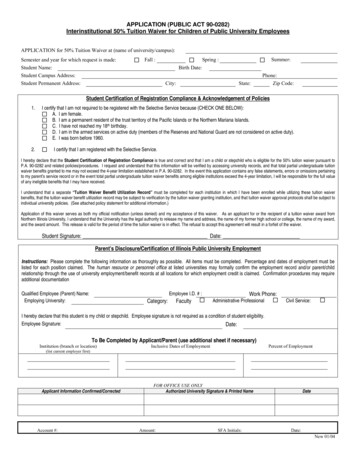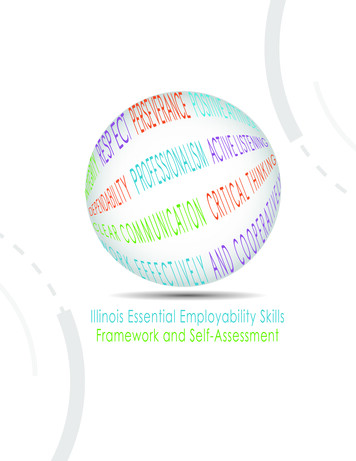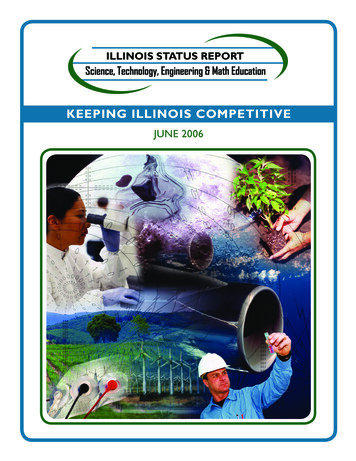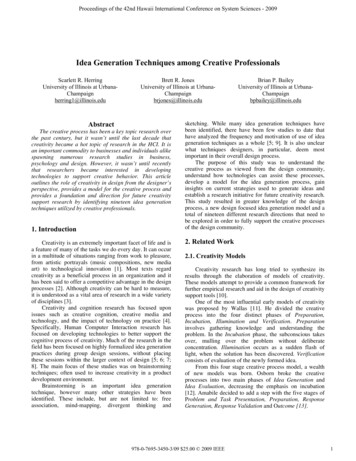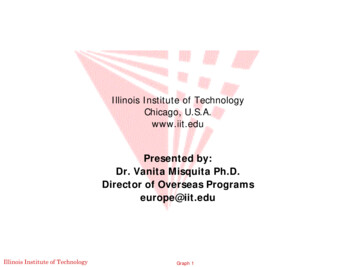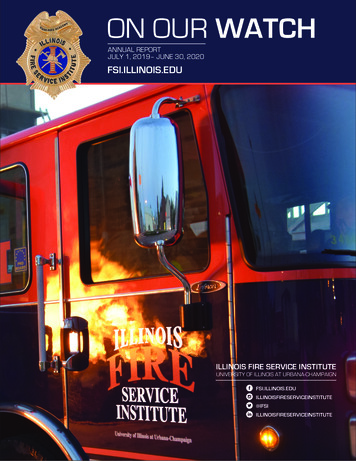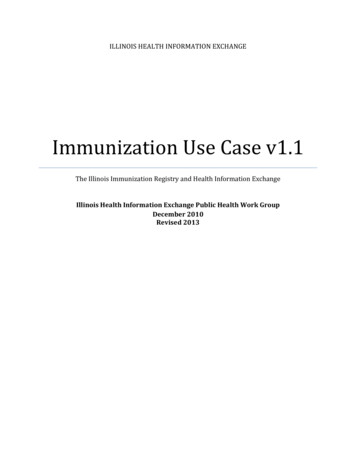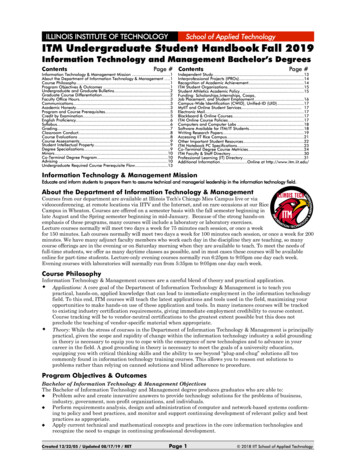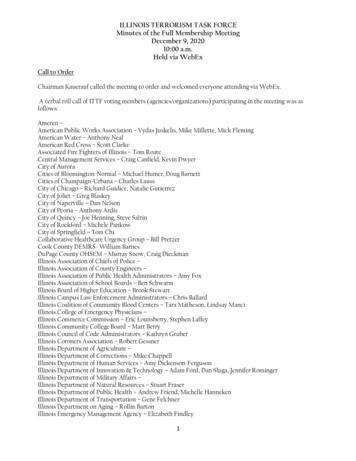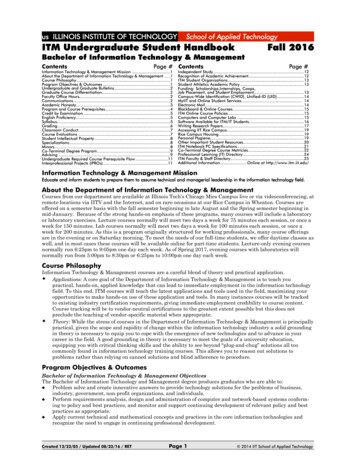
Transcription
us ILLINOIS INSTITUTE OF TECHNOLOGYSchool of Applied TechnologyITM Undergraduate Student HandbookBachelor of Information Technology & ManagementContentsPage # ContentsInformation Technology & Management Mission .1About the Department of Information Technology & Management .1Course Philosophy.1Program Objectives & Outcomes .1Undergraduate and Graduate Bulletins.2Graduate Course Differentiation.2Faculty Office Hours.2Communications.2Academic Honesty.3Program and Course Prerequisites.4Credit by Examination.5English Proficiency.5Syllabus.5Grading.6Classroom Conduct.7Course Evaluations .7Student Intellectual Property.8Specializations.8Minors.8Co-Terminal Degree Program.9Advising .9Undergraduate Required Course Prerequisite Flow.11Interprofessional Projects (IPROs).11Fall 2016Page #Independent Study.12Recognition of Academic Achievement.12ITM Student Organizations.13Student Athletics Academic Policy.13Funding: Scholarships,Internships, Coops,Job Placement, and Student Employment.13Campus-Wide Identification (CWID), Unified-ID (UID).14MyIIT and Online Student Services. 14Electronic Mail.14Blackboard & Online Courses.15ITM Online Course Policies.15Computers and Computer Labs .15Software Available for ITM/IT Students.16Writing Research Papers.17Accessing IIT Rice Campus.19Rice Campus Housing.19Personal Hygiene.19Other Important Student Resources.20ITM Notebook PC Specifications.21Co-Terminal Degree Course Matricies.22Professional Learning (IT) Directory.24ITM Faculty & Staff Directory.25Additional Information.Online at http://www.itm.iit.edu/Information Technology & Management MissionEducate and inform students to prepare them to assume technical and managerial leadership in the information technology field.About the Department of Information Technology & ManagementCourses from our department are available at Illinois Tech’s Chicago Mies Campus live or via videoconferencing, atremote locations via IITV and the Internet, and on rare occasions at our Rice Campus in Wheaton. Courses areoffered on a semester basis with the fall semester beginning in late August and the Spring semester beginning inmid-January. Because of the strong hands-on emphasis of these programs, many courses will include a laboratoryor laboratory exercises. Lecture courses normally will meet two days a week for 75 minutes each session, or once aweek for 150 minutes. Lab courses normally will meet two days a week for 100 minutes each session, or once aweek for 200 minutes. As this is a program originally structured for working professionals, many course offeringsare in the evening or on Saturday morning. To meet the needs of our full-time students, we offer daytime classes aswell, and in most cases these courses will be available online for part-time students. Lecture-only evening coursesnormally run 6:25pm to 9:05pm one day each week. As of Spring 2017, evening courses with laboratories willnormally run from 5:00pm to 8:30pm or 6:25pm to 10:00pm one day each week.Course PhilosophyInformation Technology & Management courses are a careful blend of theory and practical application.w Applications: A core goal of the Department of Information Technology & Management is to teach youpractical, hands-on, applied knowledge that can lead to immediate employment in the information technologyfield. To this end, ITM courses will teach the latest applications and tools used in the field, maximizing youropportunities to make hands-on use of these application and tools. In many instances courses will be trackedto existing industry certification requirements, giving immediate employment credibility to course content.Course tracking will be to vendor-neutral certifications to the greatest extent possible but this does notpreclude the teaching of vendor-specific material when appropriate.w Theory: While the stress of courses in the Department of Information Technology & Management is principallypractical, given the scope and rapidity of change within the information technology industry a solid groundingin theory is necessary to equip you to cope with the emergence of new technologies and to advance in yourcareer in the field. A good grounding in theory is necessary to meet the goals of a university education,equipping you with critical thinking skills and the ability to see beyond “plug-and-chug” solutions all toocommonly found in information technology training courses. This allows you to reason out solutions toproblems rather than relying on canned solutions and blind adherence to procedure.Program Objectives & OutcomesBachelor of Information Technology & Management ObjectivesThe Bachelor of Information Technology and Management degree produces graduates who are able to: Problem solve and create innovative answers to provide technology solutions for the problems of business,industry, government, non-profit organizations, and individuals. Perform requirements analysis, design and administration of computer and network-based systems conforming to policy and best practices, and monitor and support continuing development of relevant policy and bestpractices as appropriate. Apply current technical and mathematical concepts and practices in the core information technologies andrecognize the need to engage in continuing professional development.Created 12/22/05 / Updated 08/23/16 / RETPage 1 2014 IIT School of Applied Technology
ILLINOIS INSTITUTE OF TECHNOLOGYSchool of Applied TechnologyInformation Technology & Management Undergraduate Student HandbookFall 2016Bachelor of Information Technology & Management Student OutcomesBachelor of Information Technology and Management graduates should be able to:(a) Apply knowledge of computing and mathematics appropriate to the program’s student outcomes and tothe discipline(b) Analyze a problem and identify and define the computing requirements appropriate to its solution(c) Design, implement, and evaluate a computer-based system, process, component, or program to meetdesired needs(d) Function effectively on teams to accomplish a common goal(e) Recall and discuss professional, ethical, legal, security and social issues and responsibilities(f) Communicate effectively with a range of audiences(g) Analyze the local and global impact of computing on individuals, organizations, and society(h) Recognize the need for and engage in continuing professional development(i) Use current techniques, skills, and tools necessary for computing practice.(j) Use and apply current technical concepts and practices in the core information technologies of humancomputer interaction, information management, programming, networking, and web systems and technologies.(k) Identify and analyze user needs and take them into account in the selection, creation, evaluation and administration of computer-based systems.(l) Effectively integrate IT-based solutions into the user environment.(m) Describe and apply best practices and standards.(n) Assist in the creation of an effective project plan.Undergraduate and Graduate BulletinsSpecific requirements for completion of your degree are in the applicable university bulletin. In most cases thebulletin in force in the year you entered the program governs your curriculum. As of Fall 2016, the bulletins arepublished annually online only at http://bulletin.iit.edu/. The ITM Undergraduate Bulletin is t-school-appliedtechnology/.Graduate Course DifferentiationWhen a course is offered with both undergraduate and graduate students enrolled, assignments will bedifferentiated within the course to reflect the higher level of achievement expected of graduate students.w Course Numbering: Some courses are offered with both undergraduate and graduate sections sharing the sameclassroom instruction and instructor; this is reflected by the fact that the course will have both a 4XX and acorresponding 5XX section numbers. As an example, ITMO 440 has a corresponding ITMO 540 course offering.Undergraduates may not register for a 5XX course if there is a corresponding 4XX offering of the course, unless theyare taking the course as part of co-terminal degree studies. Students may not take a 5XX course if they havecompleted the corresponding 4XX course previously unless the course specifies that it may be taken more than once.Faculty Office HoursFaculty members will be available to you outside of class.w Full-Time Faculty: Full-time faculty members and adjunct faculty members who are full-time Illinois Techemployees will establish and publish/post reasonable office hours. Office hours and location must be given on anycourse web sites or Blackboard and office hours should be posted prominently on the faculty members’ office door.The location and times of office hours should match the location (Rice Campus or Mies Campus) and times (day orevening) of the course. Faculty members should be present in their office for all posted office hours. When teaching acourse that includes part-time students, faculty members should accommodate them by having some office hours onevenings and/or weekends. Additionally, faculty members must be available via email or other electronic means.w Adjunct Faculty: Adjunct faculty members should maintain one to two hours of physical presence office hoursif possible, and must be available via email or other electronic means. They may keep virtual office hours via achat application or instant messaging, but must ensure all students understand clearly how to contact them ifthis is their office hour method. Adjunct faculty members who are Illinois Tech staff members may elect to holdoffice hours in the office assigned to them for their staff position.CommunicationsThe Department of Information Technology and Management has several paths to communicate with students.w Illinois Tech Email: Your official hawk.iit.edu email address is the primary method of communication betweenthe ITM Department and you. It is important that you check your email often, and any requests from you toadvisers or faculty members should come from your university email address. If we receive email from you fromanother address, you can expect that any response will go to your iit.edu email address, or that facultymembers may not respond.w ITM Weekly Newsletter: Any announcements, news and calendar events from the ITM Department will bepublished in our weekly newsletter which will be sent to your iit.edu email every Friday during the fall andspring semesters, and occasionally during the summer term.w ITM Loopback Blog: Important announcements, news and calendar events from the ITM Department as wellas IT industry news will appear on the ITM blog, http://blogs.iit.edu/itm loopback/. Student bloggers arewelcome as well; if you would like to blog on Loopback, please contact Ray Trygstad, trygstad@iit.edu or630.447.9009.w The ITM Facebook Group: http://www.itm.iit.edu/facebook/.Created 12/22/05 / Updated 08/23/16 / RETPage 2 2016 IIT School of Applied Technology
ILLINOIS INSTITUTE OF TECHNOLOGYSchool of Applied TechnologyInformation Technology & Management Undergraduate Student HandbookFall 2016Academic HonestyAs you study in our program, you will be required to submit research papers, programs, labs, quizzes andexaminations. These works are very important because they are the metric—the measurement—of our ability toimpart knowledge and information to you; and of your ability learn, recall and apply this knowledge and information.If you do not submit work that is your own work, we have no way to measure the success of our efforts to educate you.If you are not being academically honest—if you are cheating, you are not allowing us to adequately measure oursuccess—or your success. Our single largest problem in the Information Technology and Management program iswith research papers. Many students in our program have come from other nations where secondary school andundergraduate programs never required completion of research papers, but the ability to research a topic and presentthe results of that research in a research paper is absolutely required in graduate education in the United States.If this is not a skill you already possess, you must learn it to be a success in our program.We have had reports of students boasting to employers during Curricular Practical Training that they “got through”our program by cheating. To us, this seems to be just stupid: why would you boast about being dishonest? Frankly weare very upset by this as it is completely unfair to the students who study and work hard in our program, and we aretaking every step to be sure that no one who cheats repeatedly in our program will receive a degree from Illinois Tech. Plagiarism: The code of conduct governing writing by students at Illinois Tech requires original writing, prohibitsplagiarism and provides severe sanctions for plagiarism. Original writing consists of thinking through ideas andexpressing them in your own way. Plagiarism is submitting written material that contains words that are directlyquoted without placing the quotation in quotation marks or as a paragraph that is set off from your text and is notaccompanied by a citation of the source. It can also be a statement of a fact that is not regarded as “commonknowledge” without citation of the source. Every single sentence or clause that you directly quote and every factthat is not common knowledge that you cite MUST have a properly formatted citation in the text AND a relatedentry in your bibliography. The presence of one sentence or substantial phrase in your submitted work that is adirect quote and does not have the source properly cited and included in your bibliography is automaticallyplagiarism. Submitting the words of others as your own work is cheating and will not be tolerated in our program. Writing Assistance: Often students will find material online and cut and paste this material directly into workthey submit with no citation. The main reason we find that students do this is a lack of confidence in theirability to express their thoughts well in written material. We would far prefer to see a student’s own ideas—nomatter how poorly expressed—than seeing someone else’s ideas written well! If you are at Illinois Tech’s MiesCampus, there is a Writing Center, (http://www.iit.edu/csl/hum/resources/writing center.shtml), and the staffthere will go over your paper with you line by line to help you with your grammar and use of language. Theyare there to help you learn to write better by explaining each correction to you as they are made. In addition,research librarians in Galvin Library are there to assist you in ensuring that your citations and bibliographyare correctly formatted; it is their job to assist you and you should not hesitate to ask them. Time Pressure and Research: Another reason students will plagiarize is that they are pressed for time andneed to assemble a research paper in a very short period of time. The solution to this problem is very, verysimple but represents a level of self-discipline many students have difficulty with: students need to starttheir research and writing with enough time to do a thorough and complete job in their own words. Plagiarizing by Paraphrase: When a writer uses a source, substitutes words and sentences, or even changesthe order but keeps the meaning of the original, a citation is required. In the example given below, theoriginal is on the left. The paraphrase on the right constitutes plagiarism. The writer could avoid plagiarismhere by acknowledging the source and providing a proper citation.Original: It is not generally recognized that at theParaphrase: Few people realize now that women aresame time when women are making their way intofinding jobs in all fields, that a tiny percentage of theevery corner of our work-world, only one percent ofcountry’s engineers are female. Years ago this wouldthe professional engineers in the nation are female.have surprised no one, but now it seems incredible.A generation ago, this statistic would have raised noeyebrows, but today, it is hard to believe. Mosaic Plagiarism: Here the writer lifts phrases and terms from the source and embeds them in his ownprose. An example follows in which the lifted phrases are underlined:The pressure is on to get more women into engineering. The engineering schools and major corporations haveopened wide their gates and are recruiting women zealously. Practically all women engineering graduates canfind attractive jobs. Nevertheless, at the moment, only one percent of the professional engineers in the countryare female.Mosaic plagiarism is sometimes caused by careless note taking. However, it looks dishonest and is judged assuch. The use of quotation marks around the original wording and citation avoid the problem of plagiarism.Often a better approach is to use full paraphrasing or to quote directly—with appropriate citations. Quoting and Referencing Material: Ultimately we expect that any course work that you submit will contain your ownwords and not the words of others. You must be scrupulous about separating and referencing the words of others.Faculty members will normally consider unseparated or unreferenced text that others have written to be plagiarism. Citations: Plagiarism can be avoided by providing citations for the sources of any material, including ideas,phrases, or sentences that you have used in your paper. A number of different systems are available forproviding citations. The key to all of them is that the writer must clearly identify for the reader the sources ofall material (including ideas) that have come from somewhere else. If you wish to use the words of others, inmost cases you may if you do two things: Separate the words of others from those of your own. For one or two lines, place the words in quotationmarks or for longer passages quote or indent the words using different font styles.Created 12/22/05 / Updated 08/23/16 / RETPage 3 2016 IIT School of Applied Technology
ILLINOIS INSTITUTE OF TECHNOLOGYSchool of Applied TechnologyInformation Technology & Management Undergraduate Student HandbookFall 2016 Properly reference the words. See the reference information provided in the Paper Format document for your course, or in the “Writing Research Papers” section of this handbook on page 17 below.String Quotation Problem: Sometimes a student will write a paper consisting of a string of quotations. It isusually much better for a student to provide his or her own analysis and write the paper in his or her ownwords. Many professors will reject a paper consisting primarily of material quoted from other sources becausethey do not view such a paper as the student’s own work. Due to this, many instructors may limit the amount ofmaterial that you may quote directly in an assignment. If no guidance is present, as a general rule properlyattributed quoted material should not exceed 33% of the content of your paper.Collaboration/Copying: Some students in our program have found themselves pressured by classmates to givethem answers to problems and assignments for courses they have already completed. This is also clearly cheating—it is dishonest and is unacceptable; students who give out this information are equally guilty of academicdishonesty as are those who ask for this information. If you are asked to do this the only acceptable answer is tojust say NO. It benefits neither you nor the students who are copying your answers.Acknowledgment: In addition to the above brief discussion, each student must read and ensure you understand boththe Code of Academic Honesty in the The Illinois Institute of Technology Student Handbook athttp://www.iit.edu/student affairs/handbook/information and regulations/code of academic honesty.shtml and theInformation Technology and Management Policy on Academic Honesty Violations below. You mustunderstand that if you commit academic dishonesty—if you cheat—there will be consequences. You will bepunished. At a minimum you will be assigned a grade of zero for the assignment; if it is a second offense you will begiven a failing grade for the class and lose our approval for participation in Curricular Practical Training (CPT)and/or Co-op/Internship programs. On a third offense, we will recommend that you be expelled from the university.INFORMATION TECHNOLOGY AND MANAGEMENT POLICY ON ACADEMIC HONESTY VIOLATIONSSanctions for Information Technology and Management studentsWhen an Information Technology and Management student is found to be in violation of the academic honestystandards of the university, the faculty member involved should take the following steps:1. Identical or Substantively Identical Work: If duplicate work is encountered when grading an item, assign agrade of zero for the assignment, quiz or exam on which the violation has occurred until the situation hasbeen discussed with the students involved.a. Discuss the situation with all students involved.b. If one student admits to having copied the work, or if there is clear evidence who is guilty, assign the guilty student a gradeof zero and grant full credit to student who did the work.c. If no one admits to the offense or a reasonable determination of guilt cannot be made, assign eachstudent involved a grade of zero2. Plagiarism: If a submitted item contains unattributed material that is not a student’s own work, assign agrade of zero for the assignment, quiz or exam on which the violation has occurred.3. In either case, submit an Academic Honesty Violation Report to the ITM Program Manager, AmberChatellier, PH 223, achatell@iit.edu, 312.567.5277.4. If notified by the ITM Associate Chair that the violation is a second offense, expel the student from thecourse and assign a punitive failing grade.When the ITM Program Manager is notified of a student violation of the academic honesty standards of theuniversity, the Program Manager will take the following steps:1. Determine if the violation is a first, second or third offense by consulting the student’s ITM Department fileand notify the ITM Associate Chair for undergraduate students.2. If the violation is a first offense, the ITM Associate Chair will notify the Dean of the School of AppliedTechnology and the Vice Provost for Academic Affairs, and place a notation of the violation in the student’sITM Department file.3. If the violation is a second offense, the ITM Associate Chair will notify the Dean of the School of AppliedTechnology and the Vice Provost for Academic Affairs; notify the faculty member who should expel thestudent from the course and assign a punitive failing grade; notify the Career Management Center and theInternational Office that the Department of Information Technology and Management’s approval for thestudent’s participation in Curricular Practical Training (CPT) and/or Co-op/Internship programs has beenwithdrawn for the current and next semesters; and place a notation of the violation in the student’s ITMDepartment file.4. If the violation is a third offense, the ITM Associate Chair will perform the same steps as for a second offenseand notify the Dean of the School of Applied Technology that this is a third offense. The Dean of the Schoolof Applied Technology will then recommend to the Vice Provost for Academic Affairs that the student beexpelled from the university.Program and Course PrerequisitesPrerequisites for courses and degree programs may be fulfilled though prior college course work, industrycertifications or experience, or credit by examination.w Waiver of Prerequisites Based on Certification or Experience: Program or course prerequisites may be waivedbased on industry certifications or significant experience. This waiver can be granted for courses by advisers,course instructors of the course the prerequisite is required for, or the ITM Associate Chair, Ray Trygstad. Seebelow for credit by examination information.Created 12/22/05 / Updated 08/23/16 / RETPage 4 2016 IIT School of Applied Technology
ILLINOIS INSTITUTE OF TECHNOLOGYSchool of Applied TechnologyInformation Technology & Management Undergraduate Student HandbookFall 2016Credit by ExaminationCredit by examination may be granted for any course as per current university policy as found in theUndergraduate Bulletin at ates—especially transfer students—should take note that any credit granted by examination must becompleted prior to beginning the last 45 hours of coursework for your degree.w Credit by Examination and Industry Certifications: Industry certifications may be used as the examination for creditby examination, but this credit will not normally be granted after the end of the first semester of studies in a degree.Many industry certifications may fulfill course requirements; while we recognize their value and applaud studentswho hold them, we cannot at this time grant graduate course credit for Cisco certifications. If you have industrycertifications that you believe may fulfill course requirements, contact the ITM Associate Chair, Ray Trygstad(trygstad@iit.edu or 630.447.9009), for evaluation of your certification.w Administration of Examinations for Credit by Examination: A student desiring to complete a course through creditby examination will complete the Credit by Examination form by logging into MyIIT to access the form athttp://my.iit.edu/iit/registrar/tools guide/pdf/credit by proficiency exam form.pdf, make their payment, and bringthe form to the instructor for the applicable course. The instructor may administer the midterm (if applicable) andfinal examinations from the most recent offering of the class, or may administer an oral examination, to verify thatthe student possesses an adequate level of knowledge to complete the course. Upon completion of the examination,the instructor will assign a grade on the form; if the student does NOT possess the necessary level of knowledge afailing grade will be assigned. After assigning the grade and signing the form the instructor must return the form inperson to Amber Chatallier or Angela Jarka at the Mies Campus or Cathy Foss at the Rice Campus. Once a studenthands the instructor the form, the student may not possess or handle the form again.w Credit for Proficiency for Continuing Education Unit (CEU) awarded coursework: Credit by Proficiency may begranted for coursework in the IT or INT courses of the Information Technology and International CertificatePrograms as outlined in Grading of CEU Students below, requiring a grade of “C” or better for undergraduate creditin undergraduate level courses and “B” or better for graduate credit in graduate level courses based on the finalletter grade given for the CEU coursework. If a particular section of a course is offered at both undergraduate andgraduate levels, students must complete the graduate level coursework to receive graduate credit. Meeting withyour program manager of the Office of Professional Development (OPD) at the beginning of each semester will helpensure proper level selection in coursework. The Credit by Proficiency process also begins with the student meetingwith the appropriate program manager of OPD.Successful completion of courses in IT or IN
ILLINOIS INSTITUTE OF TECHNOLOGY School of Applied Technology Information Technology & Management Undergraduate Student Handbook Fall 2016 Academic Honesty As you study in our program, you will be required to submit research papers, programs, labs, quizzes and examinations.
